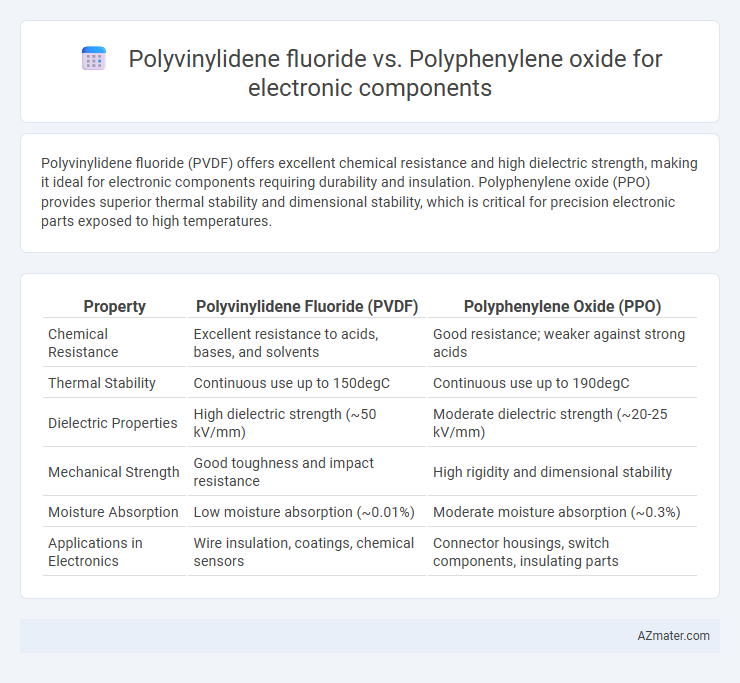Polyvinylidene fluoride (PVDF) offers excellent chemical resistance and high dielectric strength, making it ideal for electronic components requiring durability and insulation. Polyphenylene oxide (PPO) provides superior thermal stability and dimensional stability, which is critical for precision electronic parts exposed to high temperatures.
Table of Comparison
| Property | Polyvinylidene Fluoride (PVDF) | Polyphenylene Oxide (PPO) |
|---|---|---|
| Chemical Resistance | Excellent resistance to acids, bases, and solvents | Good resistance; weaker against strong acids |
| Thermal Stability | Continuous use up to 150degC | Continuous use up to 190degC |
| Dielectric Properties | High dielectric strength (~50 kV/mm) | Moderate dielectric strength (~20-25 kV/mm) |
| Mechanical Strength | Good toughness and impact resistance | High rigidity and dimensional stability |
| Moisture Absorption | Low moisture absorption (~0.01%) | Moderate moisture absorption (~0.3%) |
| Applications in Electronics | Wire insulation, coatings, chemical sensors | Connector housings, switch components, insulating parts |
Introduction to PVDF and PPO in Electronic Components
Polyvinylidene fluoride (PVDF) is a highly non-reactive and pure thermoplastic fluoropolymer known for excellent chemical resistance, high dielectric strength, and outstanding piezoelectric properties, making it ideal for advanced electronic components such as sensors, capacitors, and wire insulation. Polyphenylene oxide (PPO) offers a combination of high thermal stability, dimensional stability, and excellent electrical insulating properties, frequently used in electronic housings, connectors, and circuit board substrates. The choice between PVDF and PPO in electronic components hinges on the specific requirements for dielectric performance, thermal resistance, and mechanical robustness in the targeted application.
Chemical Structure Comparison: PVDF vs PPO
Polyvinylidene fluoride (PVDF) features a repeating unit of -[CH2-CF2]- characterized by strong C-F bonds that impart high chemical resistance and piezoelectric properties, making it ideal for electronic components requiring durability and flexibility. Polyphenylene oxide (PPO), with its rigid aromatic backbone containing alternating phenylene and oxygen atoms, offers superior thermal stability and electrical insulating properties due to its conjugated structure and high glass transition temperature. The chemical structure of PVDF provides enhanced chemical inertness and dielectric strength, whereas PPO's robust aromatic framework ensures dimensional stability and excellent electrical insulation in demanding electronic applications.
Electrical Properties: Dielectric Strength and Insulation
Polyvinylidene fluoride (PVDF) demonstrates superior dielectric strength, typically around 20-50 kV/mm, making it highly effective for high-voltage insulation in electronic components. Polyphenylene oxide (PPO) offers good electrical insulation with dielectric strength generally between 15-25 kV/mm, suitable for moderate electrical applications. PVDF's higher dielectric constant and lower dielectric loss compared to PPO enhance its performance for critical insulation purposes in advanced electronic devices.
Thermal Stability and Operating Temperature Range
Polyvinylidene fluoride (PVDF) exhibits superior thermal stability with a continuous operating temperature up to 150degC, making it ideal for electronic components exposed to heat. Polyphenylene oxide (PPO) offers a broader operating temperature range, typically from -40degC to 170degC, with excellent dimensional stability and resistance to thermal degradation. PVDF's high resistance to chemicals and UV radiation also enhances its performance in harsh environments, whereas PPO provides better electrical insulation and lower moisture absorption.
Mechanical Performance and Durability
Polyvinylidene fluoride (PVDF) offers superior mechanical performance in electronic components due to its high tensile strength, excellent impact resistance, and flexibility, making it ideal for applications requiring durability under mechanical stress. Polyphenylene oxide (PPO) provides excellent dimensional stability and thermal resistance but generally exhibits lower impact resistance compared to PVDF, which may limit its durability under dynamic loads. PVDF's chemical resistance and fatigue endurance enhance long-term reliability in demanding environments, whereas PPO is advantageous where rigidity and heat resistance are prioritized over mechanical toughness.
Moisture Absorption and Environmental Resistance
Polyvinylidene fluoride (PVDF) offers superior moisture resistance with a low water absorption rate below 0.02%, making it highly suitable for electronic components exposed to humid environments. In contrast, Polyphenylene oxide (PPO) exhibits higher moisture absorption, around 0.2%, which may affect dimensional stability and electrical properties over time. PVDF also provides enhanced chemical and UV resistance compared to PPO, ensuring better long-term environmental durability in demanding electronic applications.
Processability and Manufacturing Considerations
Polyvinylidene fluoride (PVDF) exhibits superior chemical resistance and electrical insulation properties, making it ideal for electronic components requiring high purity and durability, though its relatively high melting point demands precise temperature control during processing. Polyphenylene oxide (PPO) offers excellent dimensional stability and ease of injection molding, with a lower processing temperature that enables faster cycle times and reduced thermal degradation. Manufacturing considerations favor PVDF in applications needing robust environmental resistance, while PPO excels in mass production scenarios where cost-effective processing and consistent mechanical performance are critical.
Applications in Electronic Devices
Polyvinylidene fluoride (PVDF) is widely used in electronic devices for its excellent dielectric properties, chemical resistance, and flexibility, making it ideal for capacitors, wire insulation, and piezoelectric sensors. Polyphenylene oxide (PPO) offers high mechanical strength, thermal stability, and dimensional stability, which suits applications in connectors, housings, and circuit board components. PVDF excels in environments requiring high purity and chemical inertness, while PPO is preferred for structural parts demanding heat resistance and impact durability.
Cost Analysis: PVDF vs PPO
Polyvinylidene fluoride (PVDF) typically incurs higher material costs than Polyphenylene oxide (PPO) due to its superior chemical resistance and thermal stability, which are critical for demanding electronic component applications. PPO offers a more cost-effective solution with excellent electrical insulation and mechanical properties, making it suitable for mass production in less harsh environments. Overall, the choice between PVDF and PPO hinges on balancing the higher upfront expense of PVDF against its long-term performance benefits in specialized electronic components.
Conclusion: Selecting the Right Polymer for Electronics
Polyvinylidene fluoride (PVDF) offers superior chemical resistance, high dielectric strength, and excellent thermal stability, making it ideal for demanding electronic component applications requiring durability and insulation. Polyphenylene oxide (PPO) excels in dimensional stability, mechanical strength, and low moisture absorption, which is beneficial for precision parts and environments with fluctuating humidity. Selecting the right polymer depends on specific electronic requirements, balancing PVDF's robustness with PPO's dimensional consistency for optimal performance.

Infographic: Polyvinylidene fluoride vs Polyphenylene oxide for Electronic Component
 azmater.com
azmater.com